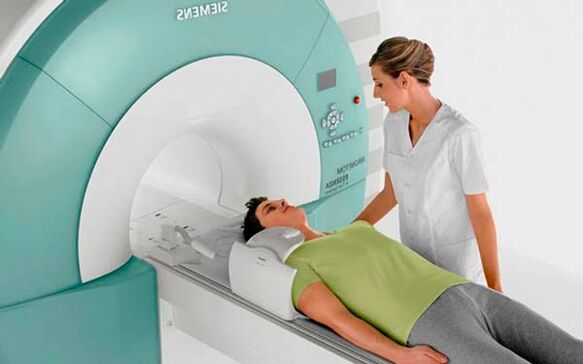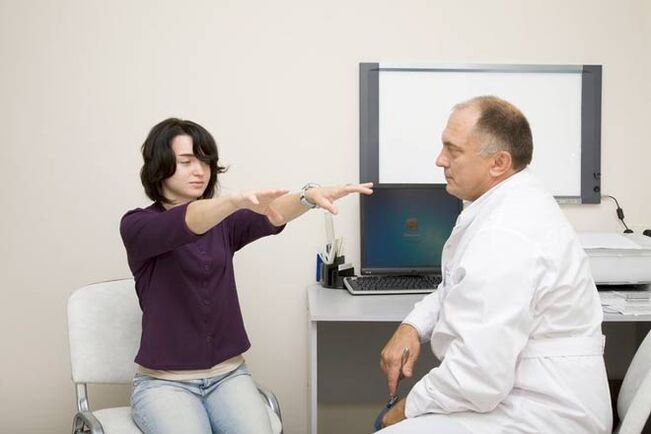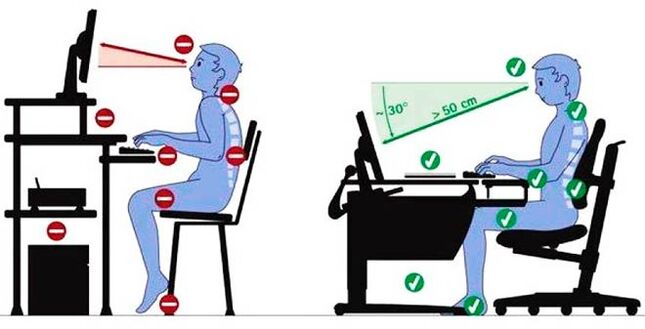Due to its relative inactivity and anatomical features, osteochondrosis rarely affects the thoracic region, but the disease cannot be mentioned infrequently. Therefore, if you feel cramps and pain in the shoulder blades, it is necessary to know what is osteochondrosis of the thoracic spine, what are its symptoms and methods of treatment.
Indeed, the disease is rarely localized in this part of the spine, but brings unpleasant consequences and sensations no less than damage to the neck and lower back. Its peculiarity can be called the symptoms of "nebulousness", in which even an experienced doctor can be mistaken at the beginning of the disease.
What is thoracic osteochondrosis?
Osteochondrosis - a degenerative -dystrophic lesion of the disc between the vertebrae and the vertebrae themselves.
As already mentioned, the disease appears in the thoracic region more rarely than in the lumbar or cervical because of features such as:
- thoracic area inactive;
- it is well fitted by the ribs and the whole chest;
- due to kyphosis (i. e. , the physiology of spinal flexion) in the thoracic region, the vertebrae experience maximum pressure in the anterior part, which is more durable.
But, unfortunately, everyone can develop the disease, especially if there are prerequisites for this.
What does an MRI of the thoracic spine show?
The diagnosis of disease that has formed in the thoracic region must be made thoroughly, and MRI shows a better actual picture than most studies.
How is an MRI done?
Everything is simple and painless - you have to lie on a bench, which enters a special spherical space, and wait for the allotted time until the equipment "illuminates" the body. Need to remove all metal objects first and warn staff if there are pacemakers, prostheses and other foreign objects in the body.
In general, previous osteochondrosis is diagnosed exclusively with the help of palpation - they examine the vertebrae, there is pain, which means that osteochondrosis is present. Now doctors complement their knowledge with special studies, among which the most informative is MRI, which makes it possible to realize degenerative phenomena in the cartilage and spine, to determine the presence of a hernia, the uniqueness of its development.
If you are not afraid of confined spaces, you can also take a nap.

Symptoms of osteochondrosis of the thoracic spine
Symptoms of dangerous osteochondrosis in the thoracic cavity manage to hide for a long time, without manifesting themselves and without causing pain or even discomfort. And then, when the damage has already caused obvious manifestations, it is sometimes difficult to determine the source of the painful sensation - it can give on the heart, internal organs, legs. Therefore, it is necessary to analyze this problem in detail.
So, doctors distinguish several types of symptoms.
Reflexes are directly related to the negative effects of disease on various receptors.
As a result, patients feel:
- pain in the shoulder blade area or just below, often circling and squeezing "like a loop";
- The focus of pain can be localized in different parts of the body - in the sternum, simulating a heart attack, on the right, disguised as the liver, and even in the lower back, such as renal colic, therefore, when diagnosing, it is often necessary to undergo a thorough examination of the organsinternal to conclude that there is a problem in the back.
Symptoms of compression appear due to squeezing or stretching of nerve roots,
as a result, there may be:
- weakness in the legs, they seem to push;
- loss of sensitivity in the limbs;
- numbness in the pinched area, a feeling of "goose bumps";
- a feeling of coma in the chest;
- tension of the surrounding muscles, which can be found during massage;
- deterioration of organ function, fortunately, neglected cases are rare.
Given the physiological peculiarities of women, sometimes the symptoms of osteochondrosis in the thoracic region are confused with other diseases.
Often, the pain radiates to the mammary glands, which automatically makes a woman think of a problem with her breasts.
Drawing, common pain resembles fibrosis, tumors and other problems with the glands, which makes you see a mammologist for consultation. And if the doctor, after undergoing tests, examinations and mammograms, does not find any abnormalities in the structure and function of the mammary glands, one can safely assume the presence of osteochondrosis.
Causes of osteochondrosis of the thoracic region
The causes of osteochondrosis for the thoracic region and other areas are the same, but for the problems localized here, clear prerequisites are needed:
- curvature of the spine, especially the thoracic region;
- the presence of bad habits;
- wear high -heeled shoes;
- being in an inappropriate position for a long time, for example, at a computer, sewing machine, weeding the garden;
- extensive physical activity;
- hereditary predisposition to back disease;
- pregnancy causes a shift of the center of gravity;
- flat feet and reluctance to wear special orthopedic soles;
- spinal cord injury.

Signs of osteochondrosis of the thoracic region
Signs of osteochondrosis in the thoracic area are pain, stiffness, muscle tension in this area. As we already know, reflex and compression syndromes are distinguished, the first of which needs to be discussed in more detail.
Dorsago and dorsalgia
The most obvious reflex syndromes of this disease are dorsago and dorsalgia. What's that?
Dorsago - cutting, severe and sharp pain in the spine, as if someone had thrown a knife backwards. Sometimes the painful sensation spreads to the heart or sternum.
The sensation is so "rainbow" that the patient is afraid to move and even breathes a sigh of relief. During throbbing, you can see muscle tension near the spinal space. Often, the attack occurs after a long sitting in an uncomfortable position and a sharp change in it. Because of the severity of the pain and its localization in the chest, the dorsago is often mistaken for a heart attack, but the cardiogram released clarifies the picture.
Dorsalgia is a painful pain that manifests itself gradually, covering the back of the chest, chest, it gets stronger with movement, especially tilting and turning the body, even from sneezing or bruising.
It is unpleasant that it is sometimes difficult to determine the most painful area - this is a superficial or deep tissue, back or chest, which complicates the formation of a correct diagnosis.

What is intercostal neuralgia?
Sometimes pain is observed in the intercostal space, then the symptoms are called intercostal neuralgia, these symptoms are characterized by:
- severe pain, covering the intercostal space, sometimes radiating to the lower back, arms or shoulders, and it lasts for hours, or even days;
- pain while examining the ribs;
- redness or pallor of the skin at the focus of inflammation, burning sensation, or conversely, numbness;
- inability to breathe evenly and deeply - every breath brings torment;
- some muscles in the chest or back twitch spontaneously.
How to treat intercostal neuralgia at home
Before treating intercostal neuralgia, you need to determine the diagnosis correctly, because the symptoms are similar to heart disease, and if you start fighting the disease at home with real myocardial problems, you can get into big trouble.
If this is not the first attack and the doctor confirms the diagnosis, you can use home treatment methods, among which the most important are:
- bed rest for 2-3 days;
- taking sedatives to relieve pain and relieve cramps;
- the use of local analgesics in gels and ointments;
- the use of heating agents - mustard plaster and pepper plaster;
- recovery of nerve tissue by taking vitamin B;
- spinal fixation, for this purpose a corset is used that holds the body in the correct position and reduces vertebral compression.
Back pain can really be overcome in a few days, but to prevent a relapse, you have to fight the cause for several months.
Atypical signs of breast osteochondrosis
In addition to clinical manifestations, thoracic osteochondrosis can have atypical symptoms that are very easily confused with other diseases. Among them:
- mimicking pain in the heart or chest in women, the discomfort can be painful for weeks, but additional examination does not show problems with the heart and chest;
- localization of pain in the iliac region, as in gastritis or colitis, or on the right, as in the case of liver dysfunction, complicated diagnosis by digestive impairment due to failure in impulse conduction along the nerve, and here it is difficult to determine priority;
- disturbances in urinary and erectile function, which also occur due to failure in the conduction of nerve endings.
But there are few clues - agitation manifests itself closer to night, growing every hour after waking up due to pinching of nerves in the back, and after the rest has passed, while disturbances in the work of the heart or other internal organs can be seen all the time.
How to treat osteochondrosis of the thoracic spine?
Treatment of osteochondrosis in the thoracic spine is a long thing, moreover, it is impossible to restore the tissue, it is only possible to slow down the process, preventing it from getting worse. But this does not mean that you can calm down, make peace and do nothing, realize the futility of effort, because treatment will give you a chance to live and work fully, and even if the neglected forms will not end in death, they will ruin life. significantly.
Drug treatment
At the first symptoms of osteochondrosis, drug treatment involves the use of pain-relieving drugs, for this purpose it is better to take non-steroidal anti-inflammatory drugs.
They are prescribed for 1-2 weeks, during which, as a rule, the pain disappears.
You can combine pills, capsules or suppositories with analgesics or local compresses (although they can cause allergies, so before using them you need to drip them into a small area of skin and wait half an hour), a similar ointment is also suitable.
Sometimes, with strong force, anti-inflammatory drugs are ineffective, and then analgesics in the form of droplets are stored.
In some cases, you have to inject painkillers along the spine, this procedure is called paravertebral blockade and is performed by a doctor in a hospital.
Then, muscle relaxation is used to relax the muscles, diuretics are prescribed against edema around the nerve endings, and blood circulation and tissue regeneration restore trophies. In the future, to prevent relapse, you should take chondroprotectors for several months.

Treatment at home
At home, you can use many non -drug methods to treat osteochondrosis, such as:
- massage;
- Exercise therapy;
- stretching exercises;
- compresses and infusions to normalize metabolism in the vertebrae.
For the last thing, here you can give advice on traditional treatment methods like this:
- rub with calendula tincture, for this, take 200 grams of vodka, triple alcohol and camphor alcohol per 100 grams of flowers, insist for 14 days and rub into the affected area before bedtime, wrap with a warm scarf;
- mix the same amount of orange peel and lemon balm ingredients and pour a glass of boiling water, leave for an hour, strain, add 1 teaspoon each. color of valerian and honey, drink ½ glass twice a day for a month.
Exercises for the thoracic area
Perhaps training for osteochondrosis in the thoracic region is most effective in preventing subsequent complications.
Gymnastics relieves cramps, relaxes muscles, strengthens them, and increases one’s physical activity. Continuous and periodic exercise speeds up blood circulation, eliminates inflammation at nerve roots, reduces pressure on the spine, and this exercise therapy is suitable not only for damage in the thoracic area, but also for any part of the spine.
But doctors do not recommend to use a set of exercises during severe periods, with poor health, problems with coordination, high blood pressure and arrhythmias.
Before training, it is better to take a shower, stretch the muscles with a massage and warm up.
So, the best practice:
- lift your shoulders 10 times;
- turn the head to the side, freezing at an extreme point for some time;
- place your hands behind your back under the shoulder blades, bend and freeze for 10 seconds;
- in a standing position, bend to the side, touch the knee with your shoulder, repeat in the other direction;
- lying on the floor, we place the roller under the thoracic area, place the hands behind the head and shrug, then move the roller a little higher, this movement is intended to stretch this part of the spinal space;
- while lying on our stomachs, we lifted our chests on the floor, first with our hands extended forward, then with our hands extended to the sides, and finally with our hands connected backwards to be the key.
Such charging helps forget about back problems for months.
Sort
Massage in the event of osteochondrosis of the thoracic area helps relieve pain, improve blood circulation and lymph outflow, relieve muscle spasms, improve their tone, and increase trophism in the intervertebral cartilage.
As a rule, the course is not started immediately on the first day, but after 3-4 days, when the main unpleasant sensations have disappeared, in rare cases, a masseur can help in the period of exacerbation.
The first session must be made gently, without excessive pressure on the tissues; both skilled hands and a special massage machine are suitable as tools. You can’t do a massage without the right experience and education - you can only exacerbate the problem, so don’t miss a course from a professional.
Manual therapy
At first glance, manual therapy is similar to massage - the same blow with your hands, but in reality, chiropractors, unlike massage therapists, do not act on muscles and skin, but on the vertebrae themselves, which require more strength and skill.
It uses percussion techniques, alternating tension and muscle relaxation, spinal flexion to eliminate disturbances in spinal structure and instrumental methods in the treatment of elderly patients.
A manual therapy professional can improve back muscle tone, restore mobility to the spine, correct curvature and prolapse of the vertebrae, and improve blood circulation.
Prevention is the best treatment
To prevent the occurrence of this unpleasant disease, you should make an effort, but it is definitely worth it. Recommended:
- monitor weight, because extra pounds are an additional burden for the spine;
- eat well and varied;
- avoid spinal hypothermia;
- playing sports, especially when working inactive, swimming is very appropriate;
- rest and warm up at work (some exercises from the above complex will be performed);
- change poses while you are at the computer for a long time, desk;
- avoid excessive pressure on the spine.

Nutritional adjustment
The condition of the joints, blood vessels and bones directly depends on the diet, and if symptoms of osteochondrosis appear, it is advisable to correct them. Therefore, it does not include:
- smoked meat that clogs the body;
- fried, causing the appearance of extra pounds;
- sweet;
- soda, especially sweet.
Instead, go to:
- boiled meats and broths from pork, chicken and rabbit;
- vegetables;
- green;
- dairy products, especially kefir, cheese and cottage cheese;
- boiled fish at least once a week;
- fruits, apples are better.
Correct posture in a dream
Chest osteochondrosis determines its own rules even in a dream, requiring you to choose the most appropriate posture. You should let go of your favorite rest in the abdomen - in this position, the head is thrown backwards, and the blood vessels are compressed, interfering with blood circulation in the brain.
The best poses for the disease are:
- on the side, when all the organs and limbs are at rest and not compressing;
- in the back;
- in the position of the fetus with the bent leg pulled to the chest, the dorsal muscles relax well in it.
I noticed that no less attention should be paid to the bed, it should be with a solid pad, a hard orthopedic mattress and a small pillow on which only the head without shoulders is placed, which is supported at body level. We must say goodbye to our favorite soft mattress and large down pillow.

Sitting posture
Even sitting with chronic osteochondrosis is definitely right! Tips that must be strictly followed:
- avoid upholstered furniture;
- select a chair until the feet reach the floor, and the depth is 2/3 of the thigh;
- there should be plenty of space under the table while sitting so you don’t have to bend your legs;
- by prolonged sitting every 10-15 minutes, change your position, warm up, walk;
- make sure the back is located at the back;
- do not bend forward to avoid muscle tension;
- while driving, place the roller under the lower back to maintain physiological bends;
- even relaxing on the couch or bed, change your position every hour, relax your back muscles, and stretch.

Osteochondrosis is not fatal, but a very unpleasant disease that must be controlled from the first manifestation. Now you know what to look for, how to recognize with various symptoms, what exercises to do with osteochondrosis and beat it. Brave and healthy!



































